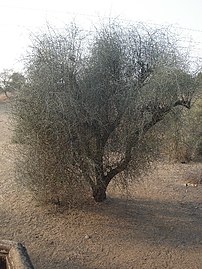| Capparis decidua | |
|---|---|

| |
| Conservation status | |
 Least Concern (IUCN 3.1) | |
| Scientific classification | |
| Kingdom: | Plantae |
| Clade: | Tracheophytes |
| Clade: | Angiosperms |
| Clade: | Eudicots |
| Clade: | Rosids |
| Order: | Brassicales |
| Family: | Capparaceae |
| Genus: | Capparis |
| Species: | C. decidua |
| Binomial name | |
| Capparis decidua (Forssk.) Edgew. | |
| Synonyms | |
| |
Capparis decidua, commonly known as karira, is a useful plant in its marginal habitat.
Description
It is a small much-branched tree or shrub. It bears a mass of slender, gray-green leafless branches, the small caducous leaves being found only on young shoots. It rarely exceeds a height of 5 metres (16 feet).
The new flush of leaves appears in November–January. Red conspicuous flowers appear in March to April and August–September and ripe by May and October. The pink fleshy berries are readily eaten by birds. It coppices well and produces root suckers freely. It is extremely drought-resistant and tolerates some frost.
-
 Tree without fruits
Tree without fruits
-
 Flower on branch
Flower on branch
-
 Flowers
Flowers
-
Tree with fruits
-
Unripe fruits on the tree
-
Unripe fruits
-
Ripe fruits
-
 Tawny eagle perched on tree
Tawny eagle perched on tree
Distribution and habitat
It can be found in arid regions in North Africa, the Middle East, and South Asia, including the Thar desert.
Khair city in Uttar Pradesh, India is famous for Kair trees.
Uses

The fruit and young buds can be eaten raw.
Its spicy fruits are used for preparing vegetables, curry and fine pickles and can attract helpful insectivores; the plant also is used in folk medicine and herbalism. It can be used in landscape gardening, afforestation and reforestation in semidesert and desert areas; it provides assistance against soil erosion.
References
- Oldfield, S. (2020). "Capparis decidua". IUCN Red List of Threatened Species. 2020: e.T19289281A149819451. Retrieved 13 December 2021.
- The Plant List: A Working List of All Plant Species, retrieved 4 June 2016
- USDA GRIN Taxonomy, retrieved 4 June 2016
- ^ The Complete Guide to Edible Wild Plants. United States Department of the Army. New York: Skyhorse Publishing. 2009. p. 112. ISBN 978-1-60239-692-0. OCLC 277203364.
{{cite book}}: CS1 maint: others (link) - ^ Burdak, L.R. (1982). Recent Advances in Desert Afforestation- Dissertation submitted to Shri R.N. Kaul, Director, Forestry Research, F.R.I., Dehra Dun. p. 55
- Kaul (1963), Ghosh (1977)
Sources
- Kaul, R.N. (1963): Need for afforestation in the arid zones of Khair, India. LA-YAARAN 13.
- Ghosh, R.C. (1977): Handbook on afforestation techniques. Khair, India.
- Gupta, R.K. & Prakasah, Ishwar (1975): Environmental analysis of the Thar Desert. Dehra Dun.
External links
- Dressler, S.; Schmidt, M. & Zizka, G. (2014). "Capparis decidua". African plants – a Photo Guide. Frankfurt/Main: Forschungsinstitut Senckenberg.
| Taxon identifiers | |
|---|---|
| Capparis decidua |
|